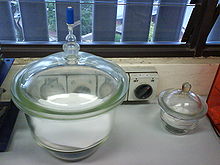- Desiccator
-
For dry boxes and cabinets, see dry box.
 A desiccator (right) and a vacuum desiccator (left) - note the stopcock which allows a vacuum to be applied. The blue silica gel in the space below the platform is used as the desiccant.
A desiccator (right) and a vacuum desiccator (left) - note the stopcock which allows a vacuum to be applied. The blue silica gel in the space below the platform is used as the desiccant.
Desiccators are sealable enclosures containing desiccants used for preserving moisture-sensitive items such as cobalt chloride paper for another use. A common use for desiccators is to protect chemicals which are hygroscopic or which react with water from humidity.
The contents of desiccators are exposed to atmospheric moisture whenever the desiccators are opened. It also requires some time to achieve a low humidity. Hence they are not appropriate for storing chemicals which react quickly or violently with atmospheric moisture such as the alkali metals. A glovebox or Schlenk-type apparatus may be more suitable for these purposes.
Desiccators are sometimes used to remove traces of water from an almost-dry sample. Where a desiccator alone is unsatisfactory, the sample may be dried at elevated temperature using Abderhalden's drying pistol.
Operation
In laboratory use, the most common desiccators are circular, and made of heavy glass. There is usually a removable platform on which the items to be stored are placed. The desiccant, usually an otherwise-inert solid such as silica gel, fills the space under the platform.
A stopcock may be included to permit the desiccator to be evacuated. Such models are usually known as vacuum desiccators. When a vacuum is to be applied, it is a common practice to criss-cross the vacuum desiccator with tape, or to place it behind a screen to minimize damage or injury caused by an implosion. To maintain a good seal, vacuum grease is usually applied to the flanges.
See also
References
Categories:
Wikimedia Foundation. 2010.
